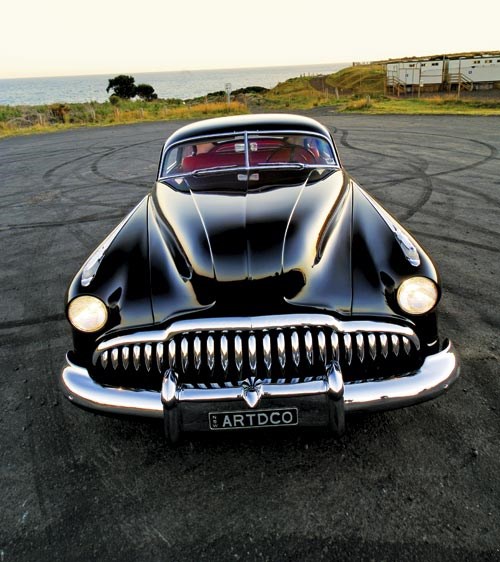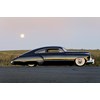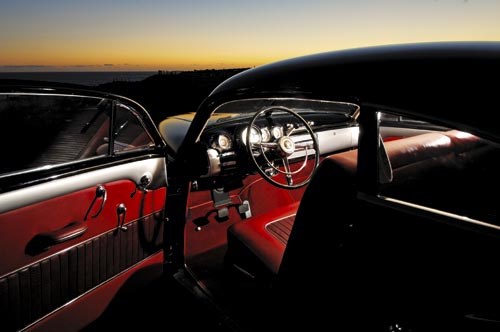1949 Buick Super Custom Review
 1949 Buick Super Custom
1949 Buick Super Custom

 1949 Buick Super Custom
1949 Buick Super Custom

 1949 Buick Super Custom
1949 Buick Super Custom

 1949 Buick Super Custom
1949 Buick Super Custom


|
|
1949 Buick Super Custom
|

|
|
1949 Buick Super Custom
|

|
|
1949 Buick Super Custom
|

|
|
1949 Buick Super Custom
|
A subtle chop has transformed an elegant coupe into a piece of art.

|
|
1949 Buick Super Custom
|
1949 Buick Super Custom
BODY BEAUTIFUL
It’s rare that I’d describe a car as achingly beautiful. There are cars that evoke overt reactions courtesy of their classic styling, or their strong, muscular stances, but here’s a car that will not only stop those nearby in their tracks, but lock them where they stand for a good hour or three.
I’m referring to the 1949 Buick Super, painstakingly built by owner Justin Hills, proprietor of Hills and Co Customs at Taree in northern NSW. The ’49 Sedanette has undergone a subtle but highly effective transformation from an elegant classic to a stunning piece of art, but it didn’t always look so immaculate.
Justin had been considering doing a custom for himself for a few years, initially leaning towards an early Mercury, and after much searching of USA websites, the Buick caught his attention in the form of a complete and original, but neglected example.
The two door coupe was found languishing in a paddock in Iowa; faded, sad, but complete with all mechanicals and trim still present. The body was strong throughout, although minor rust was present in places. All in all, it looked a great basis for a project and was destined to be resurrected in a fashion highly sympathetic to the era and the original lines of the car.
The basic specifications of the Buick include a 263 cubic inch straight eight motor, rated to approximately 124hp, with a three-speed column shift manual. An automatic Dynaflow version was newly available at the time, the first such auto transmission for Buick that proved immensely popular, as were body variants including a convertible, station wagon, and four door. Although Sedanettes like this weren’t made in huge numbers, apparently they’re not too difficult to come by in the States.
With the car in Australia, a few years went by with Justin eyeing it off in the shed, contemplating designs, wary of compromising the inherent character of the shape, as he explains.
"I wanted to build a car that would look like the car that Buick designers wanted to build, but were never quite allowed to. I was aiming for a ‘prototype’ car, something that looks from the period and doesn’t look chopped.
"The shape first drew me to the car. I was on the internet every night for probably the first two months just looking at fastbacks, studying drawings of the original cars, and looking at chopped fastbacks. There are a lot of chopped fastbacks around, and 90 per cent of them are ugly. I almost talked myself out of it! I didn’t want to kill it by making it too radical."
With a build objective in place, Justin stripped the car down, removing the mechanicals and commencing the small but essential rust repairs, predominantly in the lower sills and bottom of the huge guards, particularly behind the extensive lower brightwork. Given all the mechanicals were present, the original specification of the car was able to be retained, with parts receiving a rebuild, lubrication or tidy up, and very little needing actual replacement.
Perhaps the signature of the finished result is the subtle roof chop, and the way it flows into the curved rear end. This was the trickiest part of the build, and was tackled early on. Justin had no set plan in terms of the roof, instead taking out incremental depth until the overall effect looked perfect. Starting with a two-inch chop, two further half-inch sections were removed before he was completely satisfied with the result. It’s an intricate process to get exactly right, particularly with the bootline of the ’49, as he recalls.
"It’s very involved. The roof wasn’t such a big job, but the bootlid was. To retain the same lines after taking three inches from the roof, I had to chop the bootlid. That was three days of welding alone, and I can’t remember how many pieces are in there.
"When you bring the roof down, the top of the roof is narrower than the bottom of the roof, so you have to put in ‘pie’ cuts wherever you join it, pulling that out, pushing that in, welding it all up where it doesn’t naturally want to go. The same applies with the boot lid, with slits running along the boot, and up and down, just to allow the metal to all come back down neatly. That was a lot of time."
An area of detail Justin notes is the brightwork trim around the pillars, saying that in many such chops the result can be ugly where the chrome trim is cut apart then rewelded for the shorter pillar. The better finish is achieved by shortening the trim as required by cutting the ends.
After two solid weeks of fulltime work, the modified roof and bootlid were structurally complete, and the remainder of the body sought attention. The original panels were reattached, with the previously bolted-on guards welded carefully and leaded to provide a cleaner, smoother finish without any panel gaps or seams.
Beneath the giant bootlid, the floor was removed to allow the fuel tank to be raised, providing clearance for the rear axle assembly when the car would be ultimately lowered. To achieve the suspension drop, a set of airbags were fitted to replace the standard coils in each corner, allowing the big Buick to be parked on the ground with the chassis just touching the deck, or up to about seven inches of height for practical driving duties. Little else was required for the live rear/independent front, bar a small C-notch in the back of the chassis for diff clearance when lowered fully.
Complementing the new shape, if not in fact making the car, is the beautiful gloss black paint, achieved after endless sandblasting, rubbing and other labourious prep work and four coats of base with five coats of clear. Again, the colour was well thought through, capturing the shape and the curves, accentuating the brightwork and looking very much the elegant colour you’d expect to see on a late-’40s prestige coupe.
There’s a lot of chrome on the car and, although in good condition, it was removed and dispatched to various specialists across NSW for re-chroming, including the bumpers and that massive grille. It’s basically as per original, with the rear bar tucked closer to the rear and the protruding reversing lamps removed. The large bootlid handle was removed for a clean finish, and the exterior door handles were relocated for a flush look, now residing in the portholes in the front guards known by Buick PR types as VentiPorts. Up front, the headlights were mildly frenched, placed deeper into the guards and mounted from the inside.
The interior needed more than a little attention as 50 years of ageing coupled with an excess of rats’ nests meant the original trim, though present, had completely perished. With the overall look of the car in mind, Justin selected a classic red upholstery, deep and rich to complement the gloss black.
"I gave it to the trimmer, who pulled all the original stuff out," he explains. "I sandblasted all the frames, painted all the internal frames in gloss black, then we reinstalled the new trim.
"I went to the NSW Leather Company, who had every leather you could think of. I knew I wanted a snakeskin tuck and roll with a rich red base. I found this one, which I think is perfect, and of course it was the most expensive one there. Arrggh!"
Price aside, the result is superb, looking every bit the art deco establishment inside, with gloss black and silver metallic surfaces, soft red leather trim with natural grain, and the original winders and switchgear all present and functioning.
Completing the overall appearance of the Buick are the 15-inch red rims with whitewall tyres, covering the original four wheel drum brakes. All four wheels are covered with ’59 Dodge Lancer hupcaps, the fronts including centre bullets with the rears flush to sit under the factory original spats.
Completed, the car was unveiled at this year’s Summernats in Canberra, where the reaction was amazing; continuing through to a trip to the Kustom Nationals at Phillip Island a couple of weeks later. It has also met Justin’s expectations, representing carefully considered design and finely honed car crafting skills, whilst remaining practical enough to drive as desired.
"You’ve really got to be a car builder, not just a body man," says Justin, referring to ensuring a car is practical. "You can quickly end up building a pretty car that you can’t use. I’ve done that when I was young and stupid! I’m happy with the look of it. I haven’t driven it enough, and I’m still nervous, but it’s the car I wanted. I can take my family in it and enjoy it."
The Buick will be driven as much as possible, meaning some potential wear and tear, but parts are surprisingly accessible thanks largely to the internet. Pretty much everything is available in the ‘States, with a specialist shop supplying all conceivable parts, including brand new tail lights, ignition kits and even locks, keys and barrels.
What they can’t supply, however, is a complete ’49 Buick with a chopped roof and modifications that depicts an elegant automotive sculpture, with the attention to detail and subtle alterations that as Justin aimed for, represents a retro ‘prototype’. And as well perhaps a car designers at the time would have loved to see emerge from a showroom, but weren’t able to achieve.
LABOUR OF LOVE
As mint as the Buick is, Justin didn’t build her as a show car. Instead it emerged as a personal custom project for himself, something different from the extensive car restoration work he also performs as a major part of his classic and modified car business, Hills and Co Customs. In fact, the skilled craftsman behind the Buick says his true passion, and most of his professional background across two continents, lays with fine classics and extensive restorations on marques including Ferrari and Aston Martin, along with Mustangs and Australian muscle.
"I love classic cars and I do a lot of restoration work," he explains. "When I was an apprentice in the UK we did a Bentley for Pebble Beach. I just got to buff the brake drums, but we got best in class!
"Seriously though, a dream would be to one day get something on the grass at Pebble Beach. On a Concours restoration you do so much research, like the colour of every bolt and bracket, it’s almost painful sometimes. But on a custom like this, it almost sounds wrong, but it’s a modified car anyway so you can concentrate on what looks nice and what suits it."
While big sheds and garages are taken for granted in Oz, things weren’t so spacious for car mods in Ol’ Blighty, as Justin recalls. "We didn’t have a shed. One of my first roof chops was a Morris Minor I did out on the road. I ran extension leads across the footpath and was using grinders and welders out there, getting strange looks from drivers. I remember rubbing cars down in winter. When wet rubbing, you didn’t need a bucket of water when it was raining."
LOW RIDER
Staring at the Buick for three hours at a photo shoot is one thing, but having it perform taxi duties is another thing entirely. So after promising to wipe the drool from my clothing I accept Justin’s offer of a lift back to the hotel.
Sliding onto the bench seat, the view out front is dominated by the heavily sculptured bonnet of great proportions to contain the long motor, and I’m surprised that I’ve still ample headroom despite the chop.
The straight eight, complete with the impressive Fireball Dynaflash Eight rocker cover, starts instantly and idles smoothly and quietly, much softer than a V8 but with enough rumble to match the looks and ambitious rocker cover livery from the day.
With bags raised and the quiet road in front, the Buick is best described as torquey, effortlessly gathering speed and gliding over the bitumen as it saunters past the paddocks surrounding us. It’s no rocket, and is more gentleman’s coupe than post-war moonshine hauler, but is genuinely useable. The three-speed manual shifts smoothly, with a few graces given for the wandering cross ply tyres on our generally second-rate roads.
SPECIFICATIONS
1949 Buick Super Custom
Body: two-door coupe, modified
Engine: 263ci straight eight-cylinder, Single carburettor, 8 into 1 exhaust
Transmission: three-speed manual
Suspension: Independent front, solid rear suspension, coils replaced by adjustable airbags
Brakes: Four wheel drum
Wheels/tyres: 15-inch rims, Allstate cross ply tyres
Unique Cars magazine Value Guides
Sell your car for free right here
Get your monthly fix of news, reviews and stories on the greatest cars and minds in the automotive world.
Subscribe

.jpg)






.jpg)

